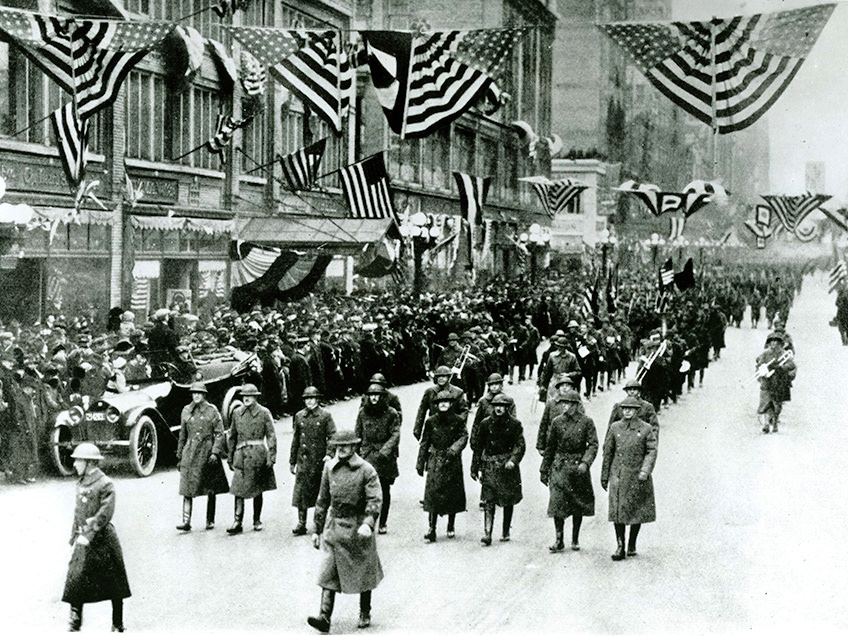
First American Legion national convention
Veterans storm into Minneapolis, pass first resolutions and close ranks after Centralia massacre.
“Minnesota Legionnaires devoted a great deal of time and energy preparing to host the first national convention of The American Legion, but the weatherman failed to cooperate.”
“Legion 50,” Ben Gimmestad, Ross & Haines, Minneapolis, Minn., 1970
Minneapolis is the home of the first American Legion National Convention.
Temperatures dip to 11 degrees above zero, with light snow, during the convention parade, and weather is later blamed for Minneapolis losing its bid to become permanent home of The American Legion National Headquarters. Indianapolis is chosen instead, and Washington, D.C., finishes second in the voting. Despite cold temperatures and snow flurries, approximately 15,000 march in the first national convention parade, and the David Wisted Post of Duluth, Minn., which already has 2,500 paid members by this time, is declared The American Legion’s first official band.
Among the veteran delegates attending the first national convention are 140 women wh are members of the newly formed organization. Also marching in the convention parade is a Boston bull terrier named “Sgt. Stubby,” a former stray that was smuggled overseas to serve alongside his master and best friend, James Robert Conroy of the Connecticut National Guard, on the western front.
On Nov. 10, The American Legion Committee on Auxiliaries meets and listens to a report from approximately 12 women of different organizations who express interest in forming an official American Legion Auxiliary. A report from the committee is delivered to the national convention that “recommends that The American Legion recognizes an Auxiliary Organization, to be governed by the rules and regulations prescribed by the National Executive Committee, to be known as the ‘Women’s Auxiliary of the American Legion,’ to which shall be eligible, all mothers, sisters, wives, and daughters of members of The American Legion, and of all men and women who died honorable deaths in the military and naval service of the United States between the declaration and the formal conclusion of the World War.”
Also Nov. 10, following the decision to name Indianapolis permanent home of the national headquarters, American Legion National Adjutant Lemuel Bolles announces that “as soon as practical” The American Legion Weekly Publishing Corp. will “also have headquarters at Indianapolis.” The magazine office, however, remains in New York until 1976.
The American Legion’s Committee on Military Policy reports during the convention that it favors universal military training but “strongly” opposes compulsory military service during peacetime.
The committee calls for a “relatively small regular Army and Navy and a citizen Army and Navy capable of rapid expansion sufficient to meet any national emergency.”
The report begins by stating: “We have had a bitter experience in the cost of unpreparedness for national defense and the lack of proper training on the part of officers and men… we realize the necessity of an immediate revision of our military and naval system and a thorough house-cleaning of the inefficient officers and methods of our entire military establishment.”
The American Legion would fight for another four decades for universal military training – or UMT – which it did not achieve but in the mid-1950s spurred major changes and improvements to the Ready Reserves, including legislation that permitted the president to activate 1 million reservists at any time of emergency.
As the first national convention continues, news hits on Nov. 11 that four American Legion members marching in an Armistice Day Parade in Centralia, Wash., are shot to death in the streets. Blamed, arrested and convicted are members of the International Workers of the World (the “wobblies”), regarded as Bolshevik-aligned radicals. When one of the suspects is jailed, a mob breaks in, pulls him out, hauls him away and hangs him from a bridge until dead. Eleven others associated with the wobblies serve sentences for their parts in the shooting. The massacre galvanizes the early American Legion at its first national convention and hardens its position against the IWW, Bolshevism and other threats to democracy.
Among the business completed on Nov. 12, the convention’s final day, is the first youth program singled out for recognition by The American Legion, thus beginning an organizational alliance that continues today in communities worldwide:
“RESOLVED, That the American Legion heartily commends the principles and achievements of the Boy Scouts and recommends that each Post assist the Scout troops in its community in whatever manner practicable.”
